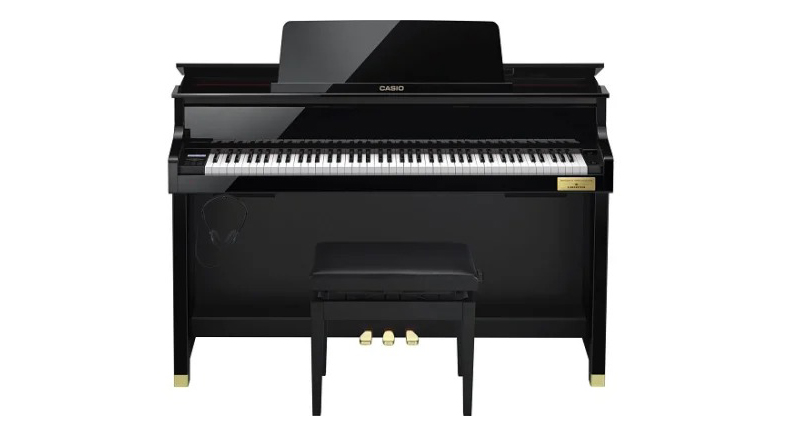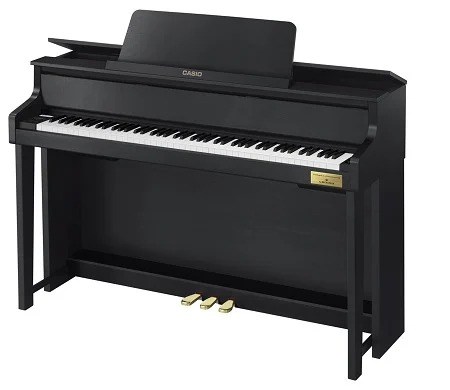Casio Celviano Grand Hybrid review
Casio's new Celviano Grand Hybrid series of digital pianos, the GP-500 and the GP-300 rated

Casio is no stranger to the digital piano market. From their longstanding Celviano line of cabinet-styled instruments for the home to their Privia series of portable, gig-ready workhorses (including the acclaimed Privia Pro PX-5S), the company has continuously broken new ground in terms of sound and performance for the price.
But with the launch of their new Celviano Grand Hybrid line, Casio attempts to re-create the acoustic piano experience to an even higher degree, with two new instruments that feature wooden keys, entirely new sample sets, and speaker systems that envelop the performer and listener alike. But how close do these new instruments get to the real deal?
Two Hearts Beat as One
Both new Celviano Grand Hybrid models are housed in upright piano-style cases. While other manufacturers offer both grand and uprightstyled enclosures for their hybrid digital pianos (e.g., Yamaha’s AvantGrand series), Casio seems to be staking a claim on the university and home market with instruments that pack a lot of sonic punch in a small physical footprint.
The flagship GP-500 is finished in polished ebony, while the GP-300 features a satin ebony, faux-wood grain finish. Both models feature Casio’s newly designed keyboard action, adjustable lid positioning, numerous hall simulators and listening positions, and other sound shaping capabilities. And while the higher-priced GP-500 includes an upgraded sound engine with more on-board keyboard instruments and tone-shaping capabilities than its lower-priced sibling, both are formidable instruments in their own right.
A Is for ACTION!
GP-300 Casio has been making major strides with regards to keyboard actions for some time now. (In fact, their Privia Pro PX-5S features a full-length, graded hammer action with simulated ivory and ebony surfaces in a 24-pound package.) But with their new Celviano Grand Hybrid line, they are delving even deeper into acoustic piano territory. At the heart of the GP-500 and GP-300 lies a completely new keyboard action, designed in cooperation with the German piano manufacturer C. Bechstein. Dubbed the “Natural Grand Hammer Action Keyboard” by Casio, this action pairs spruce piano keys to a moving mechanism that actually throws a hammer in the same way an acoustic piano does. This combination of real piano keys and surfaces paired with a triple-sensor, moving hammer system really does make a world of difference for the player. Often, digital pianos suffer from actions that are either too light or too firm and springy. But here, Casio has struck a winning combination that puts the player one step closer to the experience of playing a moving, mechanical instrument. Kudos to Casio for partnering with C. Bechstein, a recognized leader in piano manufacturing for more than 150 years.
Want all the hottest music and gear news, reviews, deals, features and more, direct to your inbox? Sign up here.

- The best MIDI keyboards for beginner and pro musicians
- Best synthesizers: keyboards, module and semi-modular synths
- Best acoustic pianos: budget to premium instruments for home and studio
Genad acoustice system
Along with its impressive new keyboard action, Casio has also gone to great lengths on the Celviano Grand Hybrid to imitate the way in which an acoustic piano projects sound. Called the Grand Acoustic System, it couples a six-speaker/four-channel audio system with a design that spreads the sound out from the instrument much in the same way a real acoustic piano does. These instruments also provide a variety of ways to alter the sound from both the player’s and listener’s perspective, from the adjustable lid and listening positions, to hall and lid simulators. There is also a special Headphone Mode where the stereo image is adjusted specifically for use with headphones.
Both models feature new sample sets made from three major styles of acoustic piano, the Berlin Grand (based on an instrument by C. Bechstein), the Hamburg Grand, and the Vienna Grand. Players of previous Casio digital pianos will undoubtedly find the Hamburg Grand sound familiar, as it has appeared in different variations on other instruments.
Each piano model has a main preset, as well as a mellow and bright version. There is also a variety of other instrument sounds onboard as expected, including electric pianos, organs and strings. (The flagship GP-500 model includes a few more of these sounds). Both models have a maximum polyphony of 256 notes.
Casio calls the brain behind its new sound engine the AIR (Acoustic and Intelligent Resonator) Grand Sound Source. This system pairs its new sample sets to sound technologies that model the interplay between the various systems on an acoustic piano. Parameters such as string and damper resonance, and damper and pedal noise are adjustable. (Pedal mechanical noise and Key on/off noise are available only on the GP-500). There are also numerous adjustable onboard effects including Reverb, Chorus and Brilliance on both Grand Hybrid models.
Onboard features
Intelligent features focused on both the performer and educator abound on the Celviano Grand Hybrid and are accessible from the keypad and LCD to the left of the keyboard. You’ll find the capabilities you would expect, such as a metronome, transposition, and the ability to split and layer. (Players can layer up to two sounds and split the keyboard into two zones, as well as pair a layer in the right hand with a split in the left hand.) More adventurous fare includes Concert Play, which allows you to rehearse and perform well-known pieces along with a sampled orchestra; Scene (available on the GP-500 only), which lets you save customized sounds and environments; and Duet Mode, which allows you to set both halves of the keyboard to the same range to facilitate instruction and practice. Other notable features include an on-board audio recorder that tracks stereo WAV files (44.1kHz/24-bit) directly to a USB flash drive and a 2-track MIDI recorder with a capacity of up to 5,000 notes.

For connectivity, the Celviano Grand Hybrids provide USB, MIDI I/O, 1/4" inputs and outputs, and headphone jacks. And both models have three pedals and support half-pedalling.
The feel and sound
I first heard the Celviano Grand Hybrid back in September when famed classical pianist Simone Dinnerstein was tapped to perform on it at Casio’s New York City launch party. “This I have to hear,” I thought to myself, as I walked into the performance space. Dinnerstein is well-known for her frequent social-media video postings of her practicing on a Hamburg Steinway concert grand. So how would this compact, hybrid instrument fare under her ferocious fingers? Remarkably well, it turns out. From delicate passages to roaring, pianistic fare, the Celviano Grand Hybrid sounded like a top tier concert grand under Dinnerstein’s control. Rarely have I heard a digital instrument breathe the way Casio’s did that night. Like many of those in attendance, I was more than impressed.
But hearing the Celviano Grand Hybrid is only one part of the equation. To really get a sense of the instrument’s capabilities, I visited Casio’s New Jersey headquarters to play one for myself. I sat down at the GP-300, selected the Berlin Grand preset, and started playing. From the first touch, the Celviano Grand Hybrid felt more acoustic than electronic to me. The keys have heft to them and react like those on a real piano. And there is a roundness to the piano tones that belies the digital circuitry beneath them. I felt as if I was playing an acoustic instrument; so much so that, at times, I found myself improvising in ways I would normally only do on an acoustic piano. After Casio’s employees returned from lunch to find me still entranced, one remarked, “That’s a good sign: He’s still playing!” Indeed it was.
The grand touch
I grew-up with a passion for the piano. From the budget Lauter grand I wrote my first songs on as a toddler, to the many Steinways I have owned and performed on over the years, few things exhibit the kind of gravitational pull on me that a good piano does.
That’s what surprised me about Casio’s Celviano Grand Hybrid. The more I played it, the more I wanted to keep playing it. And that’s saying a lot, especially for a digital instrument.
The three main piano sounds are terrific and represent the acoustic instruments they are derived from quite well. Like their acoustic counterparts, the Berlin Grand is warm and even, the Hamburg Grand has power and bite, and the Vienna Grand is lean and clean. These are world class sounds on their own, but paired with Casio’s Grand Acoustic System and newly-designed speakers, they truly spring to life. The additional keyboard sounds are completely useable, and the on-board features are innovative and welcome. But I suspect that for the majority of players and educators, it’s the sound and touch of the Celviano Grand Hybrid that will win them over. It sure made me want to play it again!
Verdict
Pros: An acoustic piano experience in a digital instrument. Responsive, real wooden keyboard action paired with startlingly good samples and speaker system. Innovative features for the performer and educator alike. Small footprint.
Cons: Heavy. No grand piano-style case available. Expensive when compared to other digital piano options.
Bottom line: A digital piano that feels and sounds like an acoustic instrument.
GP-500: $5,999
GP-300: $3,999
casiomusicgear.com